Seeking Reflective Cool Paint Technology for Green Buildings

KEY INFORMATION
Background/Description
In Southeast Asia, the growing focus on sustainable construction practices calls for increased demand on energy conservation and efficiency improvement solutions. As a technology and innovation hub, Singapore takes the lead by setting the “80-80-80 in 2030” targets that relates to raising the sustainability standards of existing buildings and requiring new buildings to meet the super low energy (SLE) standard.
There are generally two main approaches to achieving the above targets, 1) by adopting active energy efficiency improvement solutions - solutions that are using or producing energy, e.g., chiller plant optimisation systems, energy recovery/storage systems, etc, and 2) by employing passive energy efficiency improvements, e.g., adding insulation or non-energy consuming means to reduce the thermal transmittance of the building structure.
One of the notable solutions of passive energy efficiency improvements is the use of reflective cool paint on the exterior structures of the building, which has an estimated global market size of close to USD700m in 2023 and is projected to reach about USD900m by 2029, according to a recent study by 24ChemicalResearch. Reflective cool paint refers to paint/coating materials that achieves cooling effect by reflecting more sunlight and absorb less heat as compared to conventional paint/coating materials. It contains reflective pigments and additives that reflect a significant portion of the sun's rays in specific wavelengths back into the atmosphere.
In tropical climate, some of the key challenges for reflective cool paint include the need to adhere to diverse building surface substrates that can vary substantially, inclement weather, damaging UV rays and water permeation. All these environmental stresses lead to cracking and delamination, contributing to performance degradation of the reflective cool paint.
This Tech Need calls for reflective cool paint solutions that may address partial or most of the challenges mentioned above, and that is available for test-bedding or co-development collaborations to further adapt the reflective cool paint for tropical climate applications.
Technology Specification
- Completed lab scale functional and performance tests and verifications.
- Suggested technical performance of the cool paint:
- More than 90% solar reflectance per ASTM E1980-11 (2019).
- More than 90% thermal/infrared emissivity.
- Adhesion strength meeting ASTM D4541-17 requirements.
- Low to no volatile organic compound emissions tested per ISO 11890-2:2013.
- Achieves surface temperature reduction improvements.
- Achieves indoor temperature reduction and cooling energy saving vs. conventional paint products (based on case specific benchmarks).
- Resistant to tropical weather temperature, humidity and other environmental stresses.
- Suitable for various substrates including concrete/cement, rooftop, facade, and pavement.
- In small-scale production to support the testbedding or pilot trial in Singapore.
- Cost-effective for scale up in Singapore and regional markets.
WHAT WE ARE NOT INTERESTED IN
- Commercial ready solutions that are not available for piloting or technical co-development collaborations.
- Buy-sell or promotion of market ready solutions.
- Conceptual ideas in which there is no prototype developed yet.
Preferred Business Model
- Business Collaboration (Joint Venture)
- Licensing
- R&D Collaboration